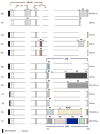The evolution and diversity of a low complexity vaccine candidate, merozoite surface protein 9 (MSP-9), in Plasmodium vivax and closely related species
- PMID: 24044894
- PMCID: PMC4066979
- DOI: 10.1016/j.meegid.2013.09.011
The evolution and diversity of a low complexity vaccine candidate, merozoite surface protein 9 (MSP-9), in Plasmodium vivax and closely related species
Abstract
The merozoite surface protein-9 (MSP-9) has been considered a target for an anti-malarial vaccine since it is one of many proteins involved in the erythrocyte invasion, a critical step in the parasite life cycle. Orthologs encoding this antigen have been found in all known species of Plasmodium parasitic to primates. In order to characterize and investigate the extent and maintenance of MSP-9 genetic diversity, we analyzed DNA sequences of the following malaria parasite species: Plasmodium falciparum, Plasmodium reichenowi, Plasmodium chabaudi, Plasmodium yoelii, Plasmodium berghei, Plasmodium coatneyi, Plasmodium gonderi, Plasmodium knowlesi, Plasmodium inui, Plasmodium simiovale, Plasmodium fieldi, Plasmodium cynomolgi and Plasmodium vivax and evaluated the signature of natural selection in all MSP-9 orthologs. Our findings suggest that the gene encoding MSP-9 is under purifying selection in P. vivax and closely related species. We further explored how selection affected different regions of MSP-9 by comparing the polymorphisms in P. vivax and P. falciparum, and found contrasting patterns between these two species that suggest differences in functional constraints. This observation implies that the MSP-9 orthologs in human parasites may interact differently with the host immune response. Thus, studies carried out in one species cannot be directly translated into the other.
Keywords: ABRA; Binding sites; Genetic diversity; MSP-9; Merozoite surface proteins; Plasmodium.
Copyright © 2013 Elsevier B.V. All rights reserved.
Figures




Similar articles
-
Clinical expression and antigenic profiles of a Plasmodium vivax vaccine candidate: merozoite surface protein 7 (PvMSP-7).Malar J. 2019 Jun 13;18(1):197. doi: 10.1186/s12936-019-2826-7. Malar J. 2019. PMID: 31196098 Free PMC article.
-
Low genetic polymorphism of merozoite surface proteins 7 and 10 in Colombian Plasmodium vivax isolates.Infect Genet Evol. 2011 Mar;11(2):528-31. doi: 10.1016/j.meegid.2010.12.002. Epub 2010 Dec 21. Infect Genet Evol. 2011. PMID: 21182986
-
Evaluation of the genetic diversity of domain II of Plasmodium vivax Apical Membrane Antigen 1 (PvAMA-1) and the ensuing strain-specific immune responses in patients from Sri Lanka.Vaccine. 2011 Oct 6;29(43):7491-504. doi: 10.1016/j.vaccine.2011.07.029. Epub 2011 Jul 23. Vaccine. 2011. PMID: 21784116
-
The use of transgenic parasites in malaria vaccine research.Expert Rev Vaccines. 2017 Jul;16(7):1-13. doi: 10.1080/14760584.2017.1333426. Epub 2017 May 30. Expert Rev Vaccines. 2017. PMID: 28525963 Review.
-
Finding the sweet spots of inhibition: understanding the targets of a functional antibody against Plasmodium vivax Duffy binding protein.Int J Parasitol. 2012 Nov;42(12):1055-62. doi: 10.1016/j.ijpara.2012.09.006. Epub 2012 Oct 12. Int J Parasitol. 2012. PMID: 23068913 Free PMC article. Review.
Cited by
-
Comparative analysis of low complexity regions in Plasmodia.Sci Rep. 2018 Jan 10;8(1):335. doi: 10.1038/s41598-017-18695-y. Sci Rep. 2018. PMID: 29321589 Free PMC article.
-
Analysis of polymorphisms and selective pressures on ama1 gene in Plasmodium knowlesi isolates from Sabah, Malaysia.J Genet. 2017 Sep;96(4):653-663. doi: 10.1007/s12041-017-0817-4. J Genet. 2017. PMID: 28947714
-
Distinct patterns of diversity, population structure and evolution in the AMA1 genes of sympatric Plasmodium falciparum and Plasmodium vivax populations of Papua New Guinea from an area of similarly high transmission.Malar J. 2014 Jun 14;13:233. doi: 10.1186/1475-2875-13-233. Malar J. 2014. PMID: 24930015 Free PMC article.
-
Evolution of the merozoite surface protein 7 (msp7) family in Plasmodium vivax and P. falciparum: A comparative approach.Infect Genet Evol. 2017 Jun;50:7-19. doi: 10.1016/j.meegid.2017.01.024. Epub 2017 Feb 2. Infect Genet Evol. 2017. PMID: 28163236 Free PMC article.
-
Immunoglobulin G responses to variant forms of Plasmodium vivax merozoite surface protein 9 upon natural infection in Thailand.Sci Rep. 2021 Feb 5;11(1):3201. doi: 10.1038/s41598-021-82928-4. Sci Rep. 2021. PMID: 33547377 Free PMC article.
References
-
- Andrade MA, Perez-Iratxeta C, Ponting CP. Protein repeats: structures, functions, and evolution. J Struct Biol. 2001;134:117–131. - PubMed
-
- Barnwell JW, Galinski MR, DeSimone SG, Perler F, Ingravallo P. Plasmodium vivax, P. cynomolgi, and P. knowlesi: identification of homologue proteins associated with the surface of merozoites. Exp Parasitol. 1999;91:238–249. - PubMed
-
- Coatney RG, Collins WE, Warren M, Contacos PG. The Primate Malaria. US Government Printing Office; Washington DC: 1971.
-
- Cole-Tobian J, King CL. Diversity and natural selection in Plasmodium vivax Duffy binding protein gene. Mol Biochem Parasitol. 2003;127:121–132. - PubMed
Publication types
MeSH terms
Substances
Grants and funding
LinkOut - more resources
Full Text Sources
Other Literature Sources
Research Materials

